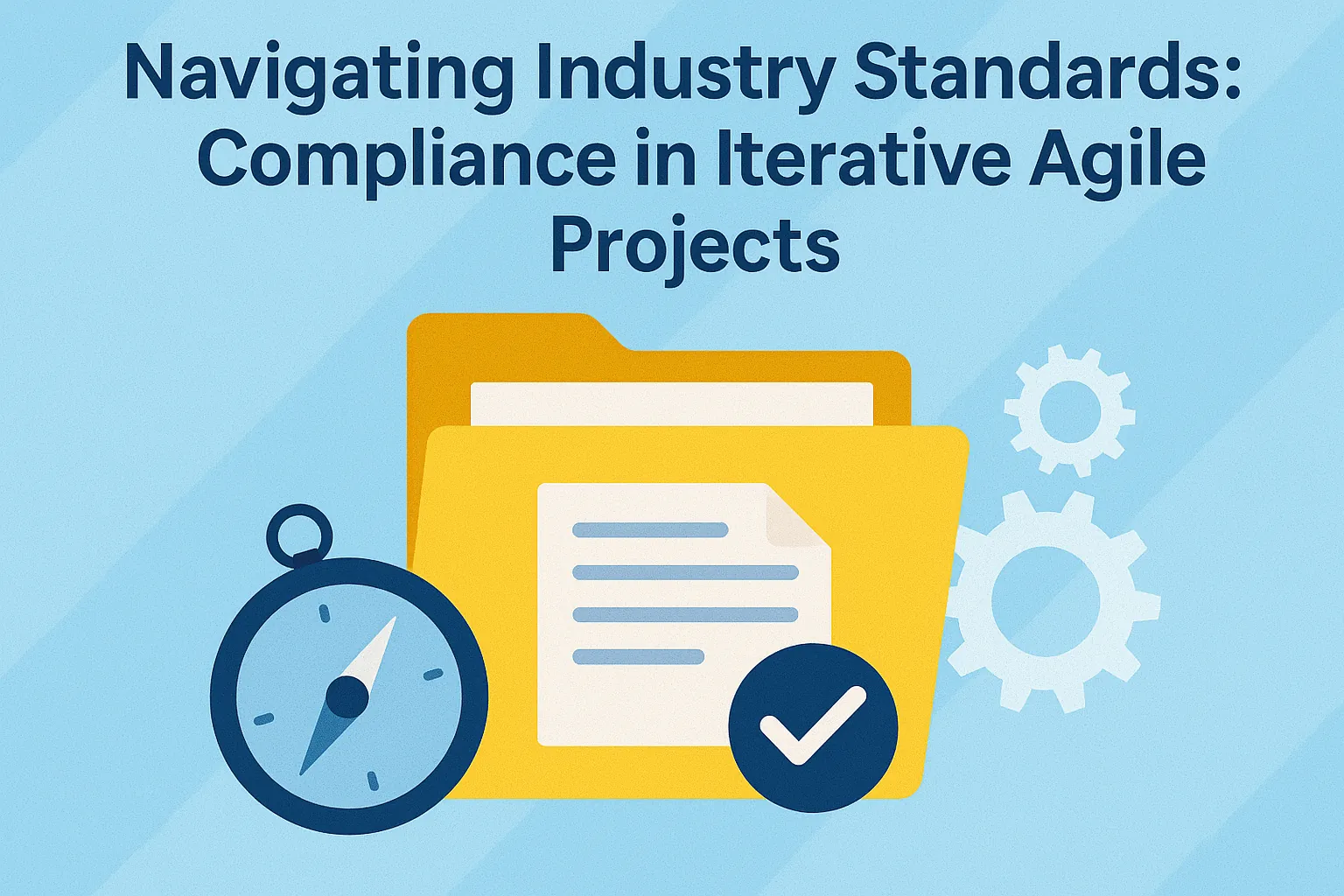Introduction to Iterative Agile Methodology
Particularly within regulated industries, understanding the iterative agile methodology is crucial for ensuring compliance while delivering high-quality results. This section aims to familiarize project managers with the core principles of this approach, highlighting its significance in navigating industry standards.
Definition of Iterative Agile Methodology
Iterative agile methodology is a project management framework that emphasizes incremental development and continuous improvement through repeated cycles (iterations). Unlike traditional project management approaches that follow a linear path, iterative agile allows teams to refine their products through regular feedback and adjustments. This methodology is particularly beneficial in environments where requirements may evolve or where compliance with industry standards is paramount.
Key Characteristics of Iterative Processes
- Flexibility: One of the hallmark traits of iterative agile is its inherent flexibility. Teams can easily adapt to changes in project scope, stakeholder feedback, or regulatory requirements. This adaptability is essential in regulated industries, where compliance mandates may shift or new standards may emerge.
- Incremental Delivery: Iterative agile promotes the delivery of work in small, manageable increments. This approach not only allows for quicker releases but also facilitates ongoing assessment of compliance with industry standards. By delivering features incrementally, project teams can ensure that each component meets regulatory requirements before moving on to the next phase.
- Continuous Improvement: The iterative nature of this methodology encourages teams to reflect on their processes and outcomes regularly. This reflection leads to continuous improvement, enabling project managers to identify compliance gaps and address them proactively.
Importance of Agile in Project Management, Especially in Regulated Industries
Agile methodologies, particularly iterative approaches, are increasingly recognized for their value in project management within regulated industries. The following points illustrate their importance:
- Enhanced Compliance: By allowing for regular reviews and adjustments, iterative agile methodologies help ensure that projects remain compliant with industry regulations throughout their lifecycle. This ongoing focus on compliance reduces the risk of non-compliance at project completion.
- Stakeholder Engagement: Iterative agile fosters greater collaboration among stakeholders, including regulatory bodies. Frequent feedback loops ensure that all parties are aligned, which is critical in regulated environments where stakeholder approval is often necessary.
- Risk Mitigation: The incremental nature of iterative agile allows for early identification and mitigation of risks associated with compliance. By addressing potential issues in real-time, project managers can avoid costly delays and rework.
The Importance of Compliance in Regulated Industries
Within regulated industries such as healthcare, finance, and pharmaceuticals, compliance is not merely a checkbox to be ticked; it is a fundamental aspect that shapes the entire project lifecycle. Understanding the nuances of compliance within an iterative agile framework is crucial for project managers aiming to navigate the complexities of industry standards effectively.
Overview of Regulatory Requirements Relevant to Different Sectors
Each regulated industry is governed by a unique set of regulatory requirements that dictate how projects should be managed. For instance:
- Healthcare: Compliance with regulations such as HIPAA (Health Insurance Portability and Accountability Act) is essential to protect patient information and ensure data security. Additionally, FDA regulations may apply to projects involving medical devices or pharmaceuticals, requiring rigorous testing and documentation.
- Finance: The financial sector is heavily regulated by laws such as the Sarbanes-Oxley Act and the Dodd-Frank Act, which impose strict requirements on financial reporting, risk management, and consumer protection. Compliance in this sector often involves regular audits and adherence to anti-money laundering (AML) regulations.
- Pharmaceuticals: The pharmaceutical industry must comply with Good Manufacturing Practices (GMP) and Good Clinical Practices (GCP), which ensure that products are consistently produced and controlled according to quality standards. This includes extensive documentation and validation processes throughout the project lifecycle.
Consequences of Non-Compliance: Legal, Financial, and Reputational
The stakes for non-compliance in regulated industries are high. The consequences can be severe and multifaceted:
- Legal Repercussions: Non-compliance can lead to legal actions, including fines, sanctions, and even criminal charges against individuals or organizations. Regulatory bodies have the authority to impose penalties that can cripple a business.
- Financial Impact: Beyond legal fees, non-compliance can result in significant financial losses due to fines, increased insurance premiums, and the costs associated with rectifying compliance failures. Additionally, projects may face delays and increased costs if compliance issues arise late in the development process.
- Reputational Damage: In today’s interconnected world, news of non-compliance can spread rapidly, leading to a loss of trust among clients, stakeholders, and the public. Rebuilding a tarnished reputation can take years and may result in lost business opportunities.
How Compliance Impacts Project Timelines and Deliverables
In an iterative agile framework, compliance considerations can significantly influence project timelines and deliverables:
- Integration of Compliance Checks: Agile methodologies emphasize flexibility and rapid iteration, but this must be balanced with the need for compliance checks at each stage of the project. This may require additional time for documentation, reviews, and approvals, which can extend project timelines.
- Prioritization of Compliance Features: Project managers must prioritize compliance-related features and requirements in the product backlog. This may mean that certain agile sprints are dedicated to ensuring compliance, potentially delaying other deliverables.
- Continuous Monitoring and Adaptation: Compliance is not a one-time task but an ongoing process. Agile teams must continuously monitor regulatory changes and adapt their processes accordingly, which can add complexity to project management.
Challenges of Maintaining Compliance in an Iterative Framework
The iterative agile methodology presents unique challenges when it comes to maintaining compliance. As project managers strive to balance the need for agility with the stringent requirements of regulatory adherence, several key challenges emerge:
- Balancing Agility and Compliance: One of the primary challenges is the inherent tension between the agile principle of rapid iteration and the need for strict compliance with industry regulations. Agile methodologies prioritize speed and flexibility, allowing teams to adapt quickly to changes. However, this can conflict with the structured processes required for compliance, leading to potential risks if regulatory standards are not met during fast-paced development cycles. Project managers must find ways to integrate compliance checks without stifling the agile process, ensuring that teams can still respond to changes while adhering to necessary regulations.
- Managing Documentation Requirements: In an iterative agile framework, documentation can become a significant hurdle. Frequent changes and updates to project deliverables can complicate the documentation process, making it challenging to maintain accurate and up-to-date records that satisfy compliance requirements. Project managers need to implement strategies that streamline documentation practices, ensuring that all necessary information is captured without overwhelming the team with excessive paperwork. This may involve adopting tools that facilitate real-time documentation updates or establishing clear guidelines on what constitutes essential documentation for compliance purposes.
- Navigating Stakeholder Expectations and Regulatory Audits: Stakeholder expectations can vary widely, especially in regulated industries where compliance is non-negotiable. Project managers must effectively communicate the agile process to stakeholders, ensuring they understand how iterative development can still meet compliance standards. Additionally, preparing for regulatory audits can be daunting, as auditors often require comprehensive evidence of compliance throughout the project lifecycle. Project managers need to establish robust processes for tracking compliance-related activities and outcomes, ensuring that they can provide the necessary documentation and evidence during audits without disrupting the agile workflow.
Strategies for Ensuring Compliance in Iterative Agile Projects
Maintaining compliance while employing iterative agile methodologies can be challenging yet essential. Project managers must navigate the complexities of compliance requirements without sacrificing the flexibility and responsiveness that agile offers. Here are actionable strategies to ensure compliance in iterative agile projects:
1. Integrating Compliance Checks into the Agile Cycle
- Planning Phase: Begin by incorporating compliance requirements into the initial planning stages. This involves identifying relevant regulations and standards that apply to the project. Create a compliance checklist that aligns with the project goals and agile principles. This checklist should be revisited and updated at each sprint planning session to ensure ongoing alignment with compliance needs.
- Execution Phase: During the execution of sprints, implement regular compliance checks. This can be achieved through daily stand-ups where team members discuss compliance-related tasks and any potential issues. Additionally, consider using automated tools that can help monitor compliance in real-time, ensuring that any deviations are caught early.
- Review Phase: At the end of each sprint, conduct a compliance review as part of the sprint retrospective. This allows the team to reflect on what compliance measures were effective and what needs improvement. Document these findings to inform future sprints and maintain a continuous improvement mindset.
2. Utilizing Compliance Frameworks and Tools Tailored for Agile Environments
- Adopt Agile-Specific Compliance Frameworks: Leverage frameworks designed specifically for agile environments, such as the Agile Compliance Framework (ACF). These frameworks provide guidelines on how to integrate compliance into agile practices without hindering agility.
- Implement Compliance Management Tools: Utilize tools that facilitate compliance tracking and reporting. Software solutions like Jira, Trello, or specialized compliance management tools can help project managers maintain visibility over compliance tasks and ensure that all team members are aware of their responsibilities.
- Automate Compliance Processes: Where possible, automate compliance-related processes to reduce manual effort and minimize the risk of human error. This can include automated documentation, reporting, and monitoring systems that align with agile workflows.
3. Engaging Compliance Teams Early and Continuously
- Early Involvement: Involve compliance teams from the outset of the project. This ensures that compliance considerations are integrated into the project design and that compliance experts can provide insights on regulatory requirements that may impact project deliverables.
- Continuous Collaboration: Foster a culture of collaboration between agile teams and compliance personnel throughout the project lifecycle. Regular check-ins and joint reviews can help identify compliance risks early and facilitate quick resolutions. This ongoing dialogue ensures that compliance is not an afterthought but a core component of the agile process.
- Training and Awareness: Provide training sessions for agile teams on compliance requirements relevant to the project. This empowers team members to take ownership of compliance tasks and understand the importance of adhering to regulations.
By implementing these strategies, project managers in regulated industries can effectively navigate the complexities of compliance within iterative agile projects. This proactive approach not only helps in meeting regulatory requirements but also enhances the overall quality and success of the project.
Best Practices for Documentation and Traceability
Maintaining compliance while employing iterative agile methodologies can be challenging. However, by implementing effective documentation and traceability practices, project managers can navigate these complexities successfully. Here are some best practices to consider:
1. Establishing a Clear Documentation Strategy
- Align with Agile Principles: Documentation in agile projects should be lightweight and focused on delivering value. Establish a strategy that emphasizes essential documentation while avoiding unnecessary bureaucracy. This means prioritizing user stories, acceptance criteria, and sprint reviews that directly contribute to project goals.
- Involve the Team: Engage the entire project team in the documentation process. Encourage collaboration and input from all members to ensure that documentation reflects the collective understanding and requirements of the project. This collaborative approach not only enhances the quality of documentation but also fosters a sense of ownership among team members.
2. Leveraging Digital Tools for Real-Time Documentation
- Utilize Agile Project Management Software: Implement digital tools that facilitate real-time documentation and version control. Tools like Jira, Trello, or Asana can help teams document changes, track progress, and maintain an up-to-date record of project activities. These platforms often include features for commenting, tagging, and linking related documents, which enhances collaboration and transparency.
- Automate Documentation Processes: Where possible, automate documentation processes to reduce manual effort and minimize errors. For instance, integrating automated reporting tools can help generate compliance reports and track changes in real-time, ensuring that documentation is always current and accurate.
3. Creating Traceability Matrices
- Link Requirements to Compliance Needs: Develop traceability matrices that clearly link project requirements to compliance needs. This matrix should outline how each requirement aligns with regulatory standards, making it easier to demonstrate compliance during audits or reviews.
- Track Changes Effectively: Use the traceability matrix to document changes throughout the project lifecycle. This includes capturing the rationale behind changes, the impact on compliance, and any adjustments made to project documentation. By maintaining a clear record of changes, project managers can ensure that all modifications are compliant and traceable.
- Regularly Review and Update: Schedule regular reviews of the traceability matrix to ensure it remains relevant and accurate. This practice not only helps in maintaining compliance but also aids in identifying any gaps in documentation or areas that require further attention.
Conclusion: The Future of Compliance in Iterative Agile Methodologies
Particularly within regulated industries, maintaining compliance while employing iterative agile methodologies is not just a necessity but a strategic advantage. As we conclude our exploration of this critical intersection, it is essential to recap the key insights that underscore the importance of compliance in iterative agile projects:
- Importance of Compliance: Compliance serves as a foundational pillar in iterative agile projects, ensuring that teams adhere to industry regulations and standards while remaining flexible and responsive to change. This balance is crucial for mitigating risks and fostering trust among stakeholders, which is particularly vital in sectors such as healthcare, finance, and pharmaceuticals where regulatory scrutiny is intense.
- Culture of Compliance and Continuous Improvement: To thrive in an iterative agile environment, organizations must cultivate a culture that prioritizes compliance alongside agility. This involves integrating compliance checks into the agile process, encouraging teams to view compliance not as a hindrance but as an enabler of quality and innovation. Continuous improvement should be a core value, where teams regularly assess and refine their compliance practices to adapt to new regulations and industry standards.
- Community Engagement: The journey towards effective compliance in iterative agile methodologies is ongoing and collaborative. Project managers are encouraged to share their experiences, challenges, and successful strategies within the project management community. By fostering open dialogue and knowledge exchange, professionals can collectively enhance their understanding and implementation of compliance measures, ultimately leading to more successful project outcomes.
As we look to the future, the integration of compliance within iterative agile frameworks will continue to evolve. Project managers must remain vigilant, adaptable, and proactive in their approach to compliance, ensuring that their teams are equipped to navigate the complexities of regulatory requirements while delivering value through agile practices. Embracing this dual focus will not only enhance project success but also contribute to the overall integrity and reputation of the organizations they represent.
Find out more about Shaun Stoltz https://www.shaunstoltz.com/about/.
This post was written by an AI and reviewed/edited by a human.



